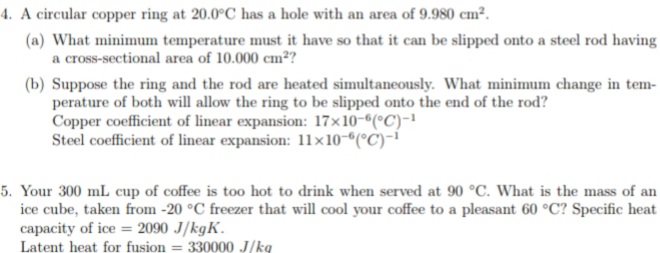4. A circular copper ring at 20.0°C has a hole with an area of 9.980 cm². (a) What minimum temperature must it have so that it can be slipped onto a steel rod having a cross-sectional area of 10.000 cm²? (b) Suppose the ring and the rod are heated simultaneously. What minimum change in tem- perature of both will allow the ring to be slipped onto the end of the rod? Copper coefficient of linear expansion: 17x10-(C)-1 Steel coefficient of linear expansion: 11x10-(°C)-!
4. A circular copper ring at 20.0°C has a hole with an area of 9.980 cm². (a) What minimum temperature must it have so that it can be slipped onto a steel rod having a cross-sectional area of 10.000 cm²? (b) Suppose the ring and the rod are heated simultaneously. What minimum change in tem- perature of both will allow the ring to be slipped onto the end of the rod? Copper coefficient of linear expansion: 17x10-(C)-1 Steel coefficient of linear expansion: 11x10-(°C)-!
College Physics
1st Edition
ISBN:9781938168000
Author:Paul Peter Urone, Roger Hinrichs
Publisher:Paul Peter Urone, Roger Hinrichs
Chapter14: Heat And Heat Transfer Methods
Section: Chapter Questions
Problem 54PE: A glass coffee pot has a circular bottom with a 9.00-cm diameter in contact with a heating element...
Related questions
Question

Transcribed Image Text:4. A circular copper ring at 20.0°C has a hole with an area of 9.980 cm².
(a) What minimum temperature must it have so that it can be slipped onto a steel rod having
a cross-sectional area of 10.000 cm²?
(b) Suppose the ring and the rod are heated simultaneously. What minimum change in tem-
perature of both will allow the ring to be slipped onto the end of the rod?
Copper coefficient of linear expansion: 17×10-(°C)-1
Steel coefficient of linear expansion: 11x10-°(°C)-i
5. Your 300 mL cup of coffee is too hot to drink when served at 90 °C. What is the mass of an
ice cube, taken from -20 °C freezer that will cool your coffee to a pleasant 60 °C? Specific heat
capacity of ice = 2090 J/kgK.
Latent heat for fusion = 330000 J/kq
Expert Solution
This question has been solved!
Explore an expertly crafted, step-by-step solution for a thorough understanding of key concepts.
This is a popular solution!
Trending now
This is a popular solution!
Step by step
Solved in 3 steps

Recommended textbooks for you

College Physics
Physics
ISBN:
9781938168000
Author:
Paul Peter Urone, Roger Hinrichs
Publisher:
OpenStax College

Physics for Scientists and Engineers, Technology …
Physics
ISBN:
9781305116399
Author:
Raymond A. Serway, John W. Jewett
Publisher:
Cengage Learning

Physics for Scientists and Engineers with Modern …
Physics
ISBN:
9781337553292
Author:
Raymond A. Serway, John W. Jewett
Publisher:
Cengage Learning

College Physics
Physics
ISBN:
9781938168000
Author:
Paul Peter Urone, Roger Hinrichs
Publisher:
OpenStax College

Physics for Scientists and Engineers, Technology …
Physics
ISBN:
9781305116399
Author:
Raymond A. Serway, John W. Jewett
Publisher:
Cengage Learning

Physics for Scientists and Engineers with Modern …
Physics
ISBN:
9781337553292
Author:
Raymond A. Serway, John W. Jewett
Publisher:
Cengage Learning

Principles of Physics: A Calculus-Based Text
Physics
ISBN:
9781133104261
Author:
Raymond A. Serway, John W. Jewett
Publisher:
Cengage Learning

College Physics
Physics
ISBN:
9781305952300
Author:
Raymond A. Serway, Chris Vuille
Publisher:
Cengage Learning

College Physics
Physics
ISBN:
9781285737027
Author:
Raymond A. Serway, Chris Vuille
Publisher:
Cengage Learning